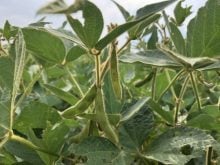Purdue Extension agronomist Bob Nielsen reports that a period of extremely dry weather followed by later-season rain has left some Indiana corn with husks shorter than their ears, exposing kernels and portending reduced grain quality at harvest.
The phenomenon, often described as “ears outgrowing their husks,” is the result of stunted husk leaf development combined with fairly normal ear or cob elongation, Nielsen said in a Purdue extension service release.
The main symptom farmers see is the ears elongated beyond the end of the husk leaves, which leaves kernels exposed to insects, birds and weathering. Damaged kernels are then vulnerable to fungal infection and ear mould development.
Read Also

Pulse Weekly: SPG looks back at harvest, ahead to trade
Saskatchewan Pulse Growers executive director Carl Potts said this year’s harvest had strong yields as the organization now works on international trade.
“If high percentages of ears are affected, overall grain quality can be compromised to the point that grain buyers may discount prices accordingly,” Nielsen said.
He said stunted husk leaves and exposed ears seem to be related to a combination of severe stress before or during pollination that is relieved in the initial weeks following pollination. For example, the most common combination of conditions resulting in ears outgrowing their husks is severe heat and drought stress followed by cooler temperatures and rainfall.
Stunted husk leaves are similar to what can occur in the whole plant when subjected to long periods of heat and drought stress, Nielsen said.
“The potential for husk leaf expansion and elongation seems to be permanently restricted, while the ear is able to continue elongation upon relief of the stress,” he said.
















